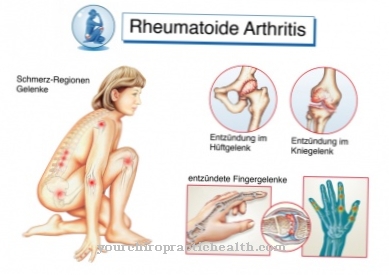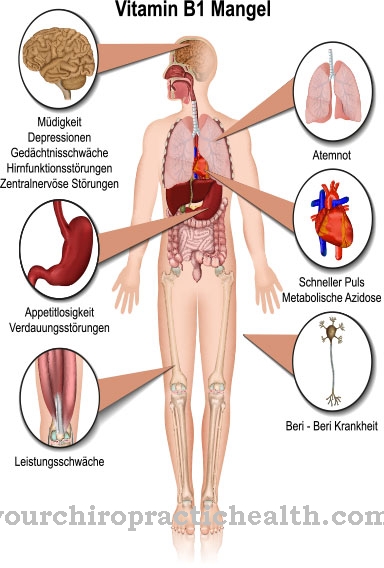From one Cervical dystocia one speaks when the birth process is delayed by insufficient enlargement of the cervix. The cervical dystocia is usually triggered by functional disorders. The inadequate opening despite sufficient contractions leads to painful cramps.
What is cervical dystocia?
The Cervical dystocia is a complication of the labor process. Usually, the cervix opens gradually as the labor begins. In early labor, it should dilate to three to five centimeters in diameter. When the cervix is about eight to nine centimeters open, the contractions phase begins. With a diameter of the cervix of about ten centimeters, the baby's head can be born. If the cervix does not open or opens too slowly, cervical dystocia is present.
causes
Cervical dystocia is based on either functional or pathological-anatomical disorders. In most cases, cervical dystocia is caused by functional disorders. These are mostly due to spasms of the cervix or the lower part of the uterus. These spasms, in turn, are usually triggered by uncoordinated or excessive labor.
Typically, opening pains occur about three times in ten minutes with a pressure of 10 to 50 mmHg. In contrast to normal opening labor, untargeted and uncoordinated labor does not lead to the opening of the cervix. The spasms of the cervix can also be psychological. Primarily first-time women from the age of 38 to 40 are affected by this psychologically-related spasm. In addition, the so-called endogenous prostaglandins respond less well in late first-time women than in younger women.
Prostaglandins are local hormones that play a role in labor, among other things. Due to this hormonal disruption, the cervix, including the cervix, remains rigid. This then leads to a functionally impaired birth process. Pathological-anatomical causes of cervical dystocia are present when the muscles of the cervix are pathologically changed. These pathological changes are caused, for example, by operations that can lead to scarring on the cervix.
Such scarring occurs, for example, after a conization. With a conization, part of the cervix is removed in the area of the cervix. An Emmet plastic or a cerclage and inflammation can also lead to scarring. In rare cases, the cervix can be stuck together with connective tissue. This condition is called conglutination orificii externi uteri.
Symptoms, ailments & signs
Cervical dystocia is manifested by insufficient opening of the cervix during childbirth. Labor is not affected. During palpation, i.e. during scanning, the cervix feels coarse or even convulsively hardened. The affected women feel each of the painful contractions, but the cervix does not open or only insufficiently. Usually at five to eight centimeters the limit is reached at which the cervix no longer opens. But ten centimeters would be required for the birth. Cervical dystocia can drag on for hours. The process is very exhausting and completely exhausts the woman giving birth.
Diagnosis & course of disease
The diagnosis is made by inspection and palpation of the cervix. The inspection reveals the small diameter of the cervical opening. On palpation, the cervix and cervix appear coarse and hard.
Complications
Cervical dystocia is a serious complication of labor. If the cervix does not open wide enough during labor, painful labor and sometimes bleeding will result. In general, childbirth with cervical dystocia is very exhausting and exhausting for the expectant mother.
The child can develop bruises and other injuries during birth, but these are rarely serious. Major complications can occur if the cervix opens only a few centimeters. Then a natural birth is usually not possible and a caesarean section has to be initiated.
Such an intervention is always associated with risks for the woman giving birth and the child. So it can happen that the unborn child is twisted unfavorably or is injured by the surgical tools. For the mother, a caesarean section is associated with the risk of infections, injuries and wound healing disorders. The cosmetic flaw can cause emotional complaints.
Treatment of cervical dystocia with home remedies can, depending on the method and preparation, cause complications. Alternative medical procedures such as acupuncture or remedies from homeopathy in particular harbor certain risks. Conservative drugs can cause side effects.
When should you go to the doctor?
In Europe, a child is usually born under the supervision of a doctor and a midwife. It is less advisable for a woman to have a child without the presence of medically trained personnel. The delivery can take place in an inpatient setting, in a birthing center or at home. Cooperation with obstetricians or midwives is possible at all locations. The pregnant woman should seek appropriate care well before the calculated due date.
If complications or adversities arise during the birthing process, it is possible to react to the situation as quickly as possible. In addition, the mother-to-be should be adequately informed about the process of the birth process. At the latest when labor begins, an obstetrician should be called or a hospital should be visited. If an unplanned and sudden birth occurs, an ambulance service must be alerted. Immediate action should be taken to avoid developments that are hazardous to the health of the unborn child and the mother.
Therapy & Treatment
The focus is initially on pain relief. Affected women suffer from severe pain, especially when there is spasm of the uterine muscles and the cervix. In order to protect the unborn child, pain is relieved primarily in a conservative way. A relaxing bath in the bathtub, for example, can serve this purpose. The midwife can provide detailed instructions and tips on how to better deal with labor and labor pain.
The partner can be a valuable support in the delivery room. Alternative medical procedures such as acupuncture, homeopathy or aromatherapy can also bring improvement. If these conservative pain relief measures are unsuccessful, pain relievers can be used. Anticonvulsant drugs (antispasmodics) can be administered as suppositories or infusions. They ensure relaxation of the cervix, which promotes the opening of the same.
Opiates can also be injected into the gluteal muscle. These have a pain relieving and calming effect. However, they have the disadvantage that the patient's respiratory drive and possibly also the newborn's breath drive are suppressed. Epidural anesthesia can be particularly helpful in the case of very severe pain and a long labor. A local anesthetic is delivered to the spinal cord through a small tube. If the cervix is very rigid, the local administration of prostaglandins can have a supportive effect. The cervix may have to be stretched manually so that the child can be born.
prevention
Functional cervical dystocia in particular can best be prevented by thorough preparation for the birth. A birth preparation course can be very helpful here. It takes away the fear of childbirth and the pain of labor and also strengthens confidence in one's own childbearing ability. During the course, the pregnant woman learns breathing exercises that make labor easier and alleviate pain.
Incorrect breathing during labor can cause cramps in the cervix. With the help of the relaxation exercises learned in the course, the woman giving birth can draw new strength during the birth. Women who have already given birth naturally do not need to fear cervical dystocia. In fact, this occurs almost exclusively in primiparous women.
Aftercare
With cervical dystocia, those affected usually have only a few and usually only limited follow-up measures available. Therefore, they should consult a doctor at the first symptoms of this disease so that there are no complications or other complaints in the further course. An early diagnosis with subsequent treatment usually has a very positive effect on the further course of the disease.
Most patients are dependent on a surgical procedure, which can alleviate the symptoms. The time after this is to be avoided from physical exertion and stressful activities. Because of their cervical dystocies, many of those affected are dependent on the help and support of their own families.
Support in everyday life is very important, although psychological help can also prevent depression and other psychological complaints from developing. The further course of the cervical dystocia depends heavily on the time of diagnosis and the severity of the disease, so that a general prediction is not possible. The focus is therefore on the early diagnosis and detection of the disease.
You can do that yourself
In the case of cervical dystocia, the measures and the possibilities for self-help are clearly limited. In some cases, they are not even available to the patient. Therefore, first and foremost, a quick and, above all, an early diagnosis of the disease is necessary so that it can be treated quickly, as it cannot lead to an independent healing.
In many cases with cervical dystocia, the support and help of one's own family is also very important. This can prevent or limit depression and other mental illnesses. Not infrequently, the partner also needs support. Often, contact with other sufferers of cervical dystocia also has a positive effect on the further course of the disease and can make everyday life a little easier, as this leads to an exchange of information.
Acupuncture or aromatherapy measures can also alleviate the symptoms, although these therapies cannot replace full medical treatment. Regular check-ups by a doctor should also be carried out so that there are no further complications or complaints.

.jpg)











.jpg)

.jpg)
.jpg)











.jpg)